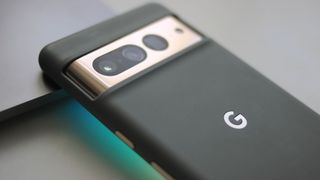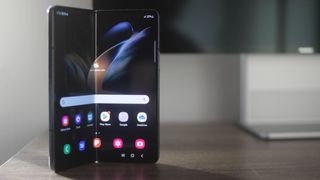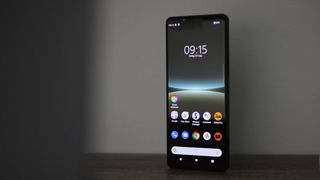Best business smartphones: The top handsets from Apple, Samsung, Google and more
The best business smartphones on the market today packed with work-focused features you need

The best business smartphones won't have everything you need to get you through the workday, but they can be a reliable backup option should tasks need finishing on the go. That requires snappy processing power, long battery life, and enough display space to see read your emails and even fix spreadsheets.
Over the last twelve months we have tried and tested some of the best around, from the latest iPhone to the best Samsung has to offer. In this article, we will provide you with a detailed review of each device, what to look for when purchasing a new smartphone for work, and also an insight into our testing methodology.
The Best Business Smartphones 2024
Apple iPhone 14 Pro
Our expert review:
Specifications
Reasons to buy
Reasons to avoid

If you're an iOS person or you're business is deep into Apple's product ecosystem then the iPhone 14 Pro is, in our opinion, the best value for money right now. The 15 models are out, but there isn't enough of a difference between the two to go for the absolute latest but there will be a price difference.
With its A16 Bionic processor, the 14 Pro is an extremely powerful smartphone. In Geekbench 5, the 14 Pro hit 5,497 for multi-threaded workloads, leaving its Android rivals in the dust. For comparison, the Samsung Galaxy S22 Ultra only managed 3,475. If it's speed you need, the iPhone 14 Pro is the clear winner in that regard.
The iPhone 14 Pro is currently priced at $999, which is still admittedly high – though that is far more affordable than the very latest iPhone 15 Pro. An argument could also be made for an older model, such as the iPhone 12, which has almost the same design, and most of the necessary features, for almost half the price – something businesses are most likely going to weigh up.
However, the 14 Pro has plenty of worthwhile extras, such as the Dynamic Island which makes emails and notifications that little bit easier to deal with.
Read our full Apple iPhone 14 Pro review for more information.
Google Pixel 7 Pro
Our expert review:
Specifications
Reasons to buy
Reasons to avoid

Google has found great success in the smartphone market with its Pixel range and that is partly to do with its innovative AI-based features. Take the Pixel 7 Pro, for example, which captured the imagination with its 'Magic Eraser' tool that allows users to make groundbreaking edits to photos.
The element that made us all go 'wow', and what really sold most on the Pixel 7 Pro, was the ability to remove objects and people from images. This is down to the innovative Tensor G2 chip and its machine-learning capabilities. It's also worth noting that it is still early days and AI capabilities on phones will become very advanced in the years to come. But for right now, the Pixel is arguably the best around.
For businesses the most appealing aspect of a Google Pixel is its native links to the Workspace suite of apps – there is no phone around that can replace the performance of a laptop, but for quick checks, minor tweaks, and little notes, the Pixel 7 Pro is great for Gmail, Google Docs, even Google Sheets. There is also potential space here for AI in the future.
Read our full Google Pixel 7 Pro review for more information.
Samsung Galaxy Fold 4
Our expert review:
Specifications
Reasons to buy
Reasons to avoid

Flip and foldable phones might seem gimmicky in the consumer space, but they do have a reasonable purpose for businesses. This is largely because they're mini tablets, offering larger screen space than your average phone. And the absolute best of the best here is the Samsung Galaxy Z Fold 4.
Packing an octa-core snapdragon 8+ Gen 1 chip, the Fold 4 is a smooth operator and business-friendly handheld. Switching apps is effortless, editing Google Docs is actually doable, and the larger screen really does allow you to work on the go.
Its Geekbench 5 scores are also noteworthy, with a multithreaded score (3,960) far above the likes of the Pixel 7 Pro and the Huawei Mate X2s. You have the processing power to handle the heaviest of work apps.
However, what really matters, and what businesses should take note of, is the inclusion of a Samsung S-Pen. The whole experience of a foldable screen gets better with a stylus, from annoying docs to creating doodles, it just offers that little bit more.
Read our full Samsung Galaxy Z Fold 4 review for more information.
Sony Xperia 5 IV
Specifications
Reasons to buy
Reasons to avoid

There is something to be said for smaller phones; they're easier to handle and ultimately use on the go, for example. But what Sony has with its Xperia 5IV is a narrow smartphone with its compact 6.1in display and its slender 8.2mm thick chassis. It is a very unobtrusive device, perfect for minor business needs.
The OLED display and its 21:9 aspect ratio and a 120Hz refresh rate are the big plus points of the device. The size is great for your thumb, as it can actually reach all parts of the display, but also good for streaming content as the aspect ratio takes away those annoying black bars. What's more, it's also very vivid with 99.9% of the sRGB color space covered under our calibrator. This is a display that matches the likes of the S22 Ultra and the iPhone 14 Pro but in a smaller way.
There is also a stellar camera system on the IV, which is less important to business users, but it does mean that the device has a more premium quality to it and therefore a more premium price. It is still under $1,000, but only just.
Read our full Sony Xperia 5 IV review for more information.
What to look for in a business smartphone
When shopping for a smartphone, it’s easy to be lured into thinking that you should simply go with whichever device boasts the highest specs - but this isn’t always the case, and in some instances, more technically advanced devices can actually offer a less satisfying experience.
For example, while a super-powerful processor may seem attractive, most flagship phones have far more CPU power than the average user needs, so unless you’re planning on using your phone to handle extremely demanding tasks like professional videography, you may find that a mid-range processor offers better value for money. It may also result in better battery life thanks to less power-hungry components, which applies equally to screen technology.
The higher a display’s resolution and refresh rate, the more charge will be needed to power it, which can quickly sap your battery. While most devices with a high refresh rate also include dynamic optimisations to mitigate this, it’s nonetheless worth bearing in mind. Generally, you should aim for a resolution of between 1080p and 1440p, and a refresh rate of at least 60Hz, which will ensure the best blend between battery life and user experience.
Regardless of how long the battery lasts, however, you should make sure to look for devices that include fast-charging support, as this will inevitably come in handy at some point. Wireless charging is also a nice feature to have, but unless you own a wireless charging pad, or your work has them dotted around the office, it's unlikely to be a feature you use very often.
You should, however, make sure that your chosen phone supports Wi-Fi 6 and 5G; these technologies may still be comparatively nascent, but skip this functionality and you may need to upgrade sooner than planned as it becomes more widespread.
Those seeking the most secure phone possible should check our best secure smartphones list.
FAQs
Are iPhones or Android phones better for business use?
There’s a certain amount of animosity that can sometimes be observed when it comes to Android vs iPhone; Android fans contend that Apple devices are needlessly expensive, prone to failure and restrictive to use, while iPhone devotees insist that Android devices are cheaply-made, poor quality hardware brimming with malware.
All of these arguments have grains of truth behind them, but on balance, it’s iOS that comes up trumps for business. As the dominant platform, it tends to be prioritised by software developers, and although high-end manufacturers like Samsung and Google can offer experiences that compete with Apple’s smartphones, the wider Android ecosystem does contain more than its fair share of duds.
However, the simple fact is that in most cases, Android and iOS are equally capable for business users. The software required for business smartphones - enterprise collaboration apps, document management systems, device management tools, and so on - are all available across both platforms, and as long as organisations don’t try and cut too many corners on the price of the unit itself, device quality is unlikely to be an issue.
How often should I update my employees’ company smartphones?
Smartphone technology moves at a seemingly breakneck pace, and every year manufacturers are touting more and more impressive specs and features. This leaves businesses with a dilemma: do they invest more money in upgrading employees’ devices every year or so, or do they sweat them for a longer period and risk missing out on the latest capabilities?
The key thing to bear in mind is that many of the features these newer smartphones boast are geared towards personal use, as opposed to business. While an improved camera is nice for taking holiday snaps, it doesn’t make much difference for most workers’ day-to-day use. With this in mind, it’s better to invest in buying higher-end devices and sweating them for a longer period of three to five years, which will offer better long-term value.
Should I get a 5G business smartphone contract?
5G has been around for a number of years now, but its introduction somehow doesn’t seem as revolutionary as previous generations of mobile broadband. Many contracts will now include 5G connectivity as standard, but it’s still worth paying a bit extra to secure a business smartphone contract that supports the latest standard - assuming your corporate devices do as well.
When employees are on the road - or working flexibly from a third location - the added speed and stability that 5G can offer is an excellent way to ensure consistent productivity, and sharing a 5G connection via hotpot can even be used as a backup broadband connection for PCs and laptops in the event of a connection failure.
How we test
We measure the effectiveness of a smartphone in a number of ways; to test the quality of the display, we’ll use a colour calibrator and the open source DisplayCal app to measure how much of the sRGB colour gamut it covers, as well as the Delta-E rating. This tells us how much of the colour spectrum it’s able to represent, and how accurate those colours are. We’ll also test the maximum brightness and contrast ratio.
Performance testing is carried out using the Geekbench 5 benchmark app, which gives separate results for single-core and multi-core operations. For phones that don’t support this app, we’ll use a different benchmarking app, then run that same app on a phone which does support Geekbench, and then use that as a basis for comparison.
To test the battery of a smartphone, we’ll charge it to 100%, use the calibrator to set the brightness to 170cd/m2 (or as near as possible) and then play a looped video in flight mode until the battery runs out. This gives us a figure that can be compared across models, but to assess real-world longevity, we track how long the battery lasts on average during our testing period.
Get the ITPro. daily newsletter
Receive our latest news, industry updates, featured resources and more. Sign up today to receive our FREE report on AI cyber crime & security - newly updated for 2024.
After a false career start producing flash games, Alan Martin has been writing about phones, wearables and internet culture for over a decade with bylines all over the web and print.
Previously Deputy Editor of Alphr, he turned freelance in 2018 and his words can now be found all over the web, on the likes of Tom's Guide, The i, TechRadar, NME, Gizmodo, Coach, T3, The New Statesman and ShortList, as well as in the odd magazine and newspaper.
He's rarely seen not wearing at least one smartwatch, can talk your ear off about political biographies, and is a long-suffering fan of Derby County FC (which, on balance, he'd rather not talk about). He lives in London, right at the bottom of the Northern Line, long after you think it ends.
You can find Alan tweeting at @alan_p_martin, or email him at mralanpmartin@gmail.com.





